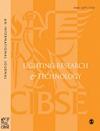色彩辨别分数结合色彩保真度和色域面积特征
IF 2.2
3区 工程技术
Q2 CONSTRUCTION & BUILDING TECHNOLOGY
引用次数: 0
摘要
本文研究了基于现有指标的颜色歧视,并提出了全球和目标颜色场景的预测因子。30名参与者在21种照明条件下进行了Farnsworth-Munsell 100色相测试。实验结果表明,在Rf-Rg和显色指数-色域面积指数坐标系中,总误差分数(TES)和调整总误差分数(TESadj)的分布均以最优点(100,100)为中心呈圆弧状。在此基础上,提出了基于色彩保真度和色域特征的全局色彩判别分数CDS1和CDS2。结果表明,CDS1 (r = 0.82, p < 0.001)和CDS2 (r = 0.81, p < 0.001)与TES具有良好的线性相关性,CDS1 (r = 0.75, p < 0.001)和CDS2 (r = 0.77, p < 0.001)与TESadj也具有良好的线性相关性。在此基础上,将全局色域划分为红黄、黄绿、绿蓝和蓝红四个局部色彩空间,并利用局部色彩属性(Rcs、local、Rhs、local和Rf、local)构建局部色域中的CDSs (CDSlocal和CDSadj,local)。线性回归结果表明,CDSlocal (r¯= 0。79)和CDSadj,local (r¯= 0)。78)可以有效地预测目标颜色场景的颜色辨别。本文章由计算机程序翻译,如有差异,请以英文原文为准。
Colour discrimination scores combining colour fidelity and gamut area characteristics
This paper investigated colour discrimination based on current available indexes, and predictors were proposed for global and targeted colour scenarios. Thirty participants conducted the Farnsworth–Munsell 100 hue test under 21 lighting conditions. The experiment results revealed that the distribution of total error score (TES) and adjusted total error score (TESadj) showed arc shapes centred on the optimal point (100, 100) in both Rf–Rg and colour rendering index–gamut area index coordinate systems. On this basis, global colour discrimination scores, CDS1 and CDS2, based on the colour fidelity and colour gamut characteristics, were proposed. The results demonstrated that both CDS1 (r = 0.82, p < 0.001) and CDS2 (r = 0.81, p < 0.001) provided good linear correlations with TES, and CDS1 (r = 0.75, p < 0.001) and CDS2 (r = 0.77, p < 0.001) also exhibited a good linear correlation with TESadj. Furthermore, the global colour gamut was divided into four local colour spaces (red–yellow, yellow–green, green–blue and blue–red), and the CDSs in the local gamut (CDSlocal and CDSadj,local) were constructed using the local colour properties, including Rcs,local, Rhs,local and Rf,local. The linear regression results demonstrated that CDSlocal ( r ¯ = 0 . 79 ) and CDSadj,local ( r ¯ = 0 . 78 ) can be effective colour discrimination predictors for the targeted colour scenarios.
求助全文
通过发布文献求助,成功后即可免费获取论文全文。
去求助
来源期刊

Lighting Research & Technology
工程技术-光学
CiteScore
5.40
自引率
16.00%
发文量
69
审稿时长
>12 weeks
期刊介绍:
Lighting Research & Technology (LR&T) publishes original peer-reviewed research on all aspects of light and lighting and is published in association with The Society of Light and Lighting. LR&T covers the human response to light, the science of light generation, light control and measurement plus lighting design for both interior and exterior environments, as well as daylighting, energy efficiency and sustainability
 求助内容:
求助内容: 应助结果提醒方式:
应助结果提醒方式:


